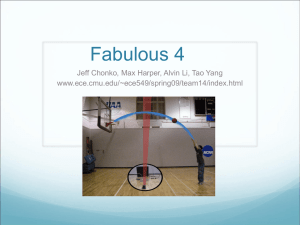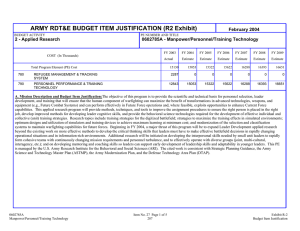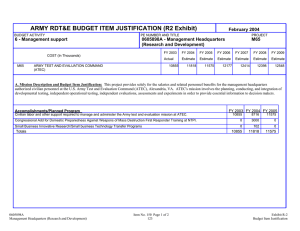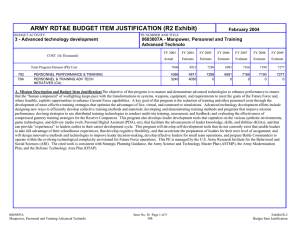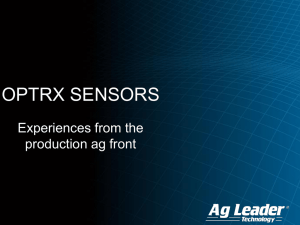ARMY RDT&E BUDGET ITEM JUSTIFICATION (R2 Exhibit) February 2005
advertisement
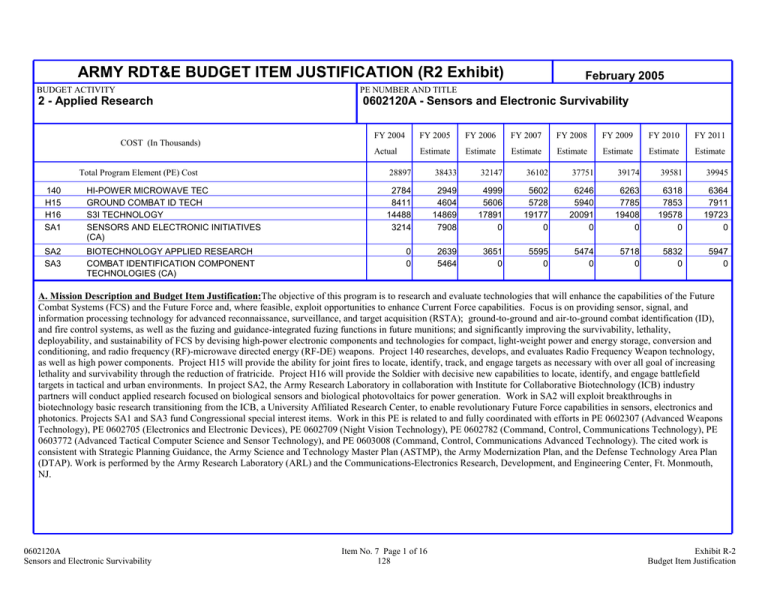
ARMY RDT&E BUDGET ITEM JUSTIFICATION (R2 Exhibit) BUDGET ACTIVITY 2 - Applied Research COST (In Thousands) Total Program Element (PE) Cost 140 H15 H16 SA1 HI-POWER MICROWAVE TEC GROUND COMBAT ID TECH S3I TECHNOLOGY SENSORS AND ELECTRONIC INITIATIVES (CA) SA2 SA3 BIOTECHNOLOGY APPLIED RESEARCH COMBAT IDENTIFICATION COMPONENT TECHNOLOGIES (CA) February 2005 PE NUMBER AND TITLE 0602120A - Sensors and Electronic Survivability FY 2004 FY 2005 FY 2006 FY 2007 FY 2008 FY 2009 FY 2010 FY 2011 Actual Estimate Estimate Estimate Estimate Estimate Estimate Estimate 28897 38433 32147 36102 37751 39174 39581 39945 2784 8411 14488 3214 2949 4604 14869 7908 4999 5606 17891 0 5602 5728 19177 0 6246 5940 20091 0 6263 7785 19408 0 6318 7853 19578 0 6364 7911 19723 0 0 0 2639 5464 3651 0 5595 0 5474 0 5718 0 5832 0 5947 0 A. Mission Description and Budget Item Justification:The objective of this program is to research and evaluate technologies that will enhance the capabilities of the Future Combat Systems (FCS) and the Future Force and, where feasible, exploit opportunities to enhance Current Force capabilities. Focus is on providing sensor, signal, and information processing technology for advanced reconnaissance, surveillance, and target acquisition (RSTA); ground-to-ground and air-to-ground combat identification (ID), and fire control systems, as well as the fuzing and guidance-integrated fuzing functions in future munitions; and significantly improving the survivability, lethality, deployability, and sustainability of FCS by devising high-power electronic components and technologies for compact, light-weight power and energy storage, conversion and conditioning, and radio frequency (RF)-microwave directed energy (RF-DE) weapons. Project 140 researches, develops, and evaluates Radio Frequency Weapon technology, as well as high power components. Project H15 will provide the ability for joint fires to locate, identify, track, and engage targets as necessary with over all goal of increasing lethality and survivability through the reduction of fratricide. Project H16 will provide the Soldier with decisive new capabilities to locate, identify, and engage battlefield targets in tactical and urban environments. In project SA2, the Army Research Laboratory in collaboration with Institute for Collaborative Biotechnology (ICB) industry partners will conduct applied research focused on biological sensors and biological photovoltaics for power generation. Work in SA2 will exploit breakthroughs in biotechnology basic research transitioning from the ICB, a University Affiliated Research Center, to enable revolutionary Future Force capabilities in sensors, electronics and photonics. Projects SA1 and SA3 fund Congressional special interest items. Work in this PE is related to and fully coordinated with efforts in PE 0602307 (Advanced Weapons Technology), PE 0602705 (Electronics and Electronic Devices), PE 0602709 (Night Vision Technology), PE 0602782 (Command, Control, Communications Technology), PE 0603772 (Advanced Tactical Computer Science and Sensor Technology), and PE 0603008 (Command, Control, Communications Advanced Technology). The cited work is consistent with Strategic Planning Guidance, the Army Science and Technology Master Plan (ASTMP), the Army Modernization Plan, and the Defense Technology Area Plan (DTAP). Work is performed by the Army Research Laboratory (ARL) and the Communications-Electronics Research, Development, and Engineering Center, Ft. Monmouth, NJ. 0602120A Sensors and Electronic Survivability Item No. 7 Page 1 of 16 128 Exhibit R-2 Budget Item Justification ARMY RDT&E BUDGET ITEM JUSTIFICATION (R2 Exhibit) BUDGET ACTIVITY PE NUMBER AND TITLE B. Program Change Summary 2 - Applied Research February 2005 0602120A - Sensors and Electronic Survivability FY 2005 FY 2006 FY 2007 Previous President's Budget (FY 2005) 25629 31703 34843 Current Budget (FY 2006/2007 PB) 38433 32147 36102 Total Adjustments 12804 444 1259 444 1259 Net of Program/Database Changes Congressional Program Reductions -513 Congressional Rescissions Congressional Increases 13950 Reprogrammings SBIR/STTR Transfer -633 Adjustments to Budget Years Change Summary Explanation: Five FY05 Congressional Adds totaling $13950 were added to this PE. FY05 Congressional Adds with no R-2A: ($4028) Digital Radio Frequency Tags (DraFT), Project SA3: The purpose of this one year Congressional add is to fund research on a low cost “chip” implementation approach for radio frequency tag design. No additional funding is required to complete this project. ($1438) Disposable Sensors for Battlefield and Urban Warfare, Project SA1: The purpose of this one year Congressional add is to fund research on disposable sensors for use on the battlefield and in urban warfare. No additional funding is required to complete this project. ($4795) Optical Combat Identification System Prototype Development and Testing, Project SA3: The purpose of this Congressional add is to research develop an optical combat identification prototype for development and testing. No additional funding is required to complete this project. ($1678) Portable Chemical-Biological Agent Detection System, Project SA1: The purpose of this one year Congressional add is to fund research on 0602120A Sensors and Electronic Survivability Item No. 7 Page 2 of 16 129 Exhibit R-2 Budget Item Justification ARMY RDT&E BUDGET ITEM JUSTIFICATION (R2 Exhibit) BUDGET ACTIVITY 2 - Applied Research February 2005 PE NUMBER AND TITLE 0602120A - Sensors and Electronic Survivability technologies to develop a portable chemical-biological agent detection system. No additional funding is required to complete this project. ($1438) Small Airship Surveillance System-Lite Remotely Piloted System, Project SA1: The purpose of this one year Congressional add is to fund research in small airship surveillance systems. No additional funding is required to complete this project. 0602120A Sensors and Electronic Survivability Item No. 7 Page 3 of 16 130 Exhibit R-2 Budget Item Justification ARMY RDT&E BUDGET ITEM JUSTIFICATION (R2a Exhibit) BUDGET ACTIVITY 2 - Applied Research COST (In Thousands) 140 HI-POWER MICROWAVE TEC February 2005 PE NUMBER AND TITLE 0602120A - Sensors and Electronic Survivability PROJECT 140 FY 2004 FY 2005 FY 2006 FY 2007 FY 2008 FY 2009 FY 2010 FY 2011 Actual Estimate Estimate Estimate Estimate Estimate Estimate Estimate 2784 2949 4999 5602 6246 6263 6318 6364 A. Mission Description and Budget Item Justification:This project researches, develops and evaluates Radio Frequency (RF) Directed Energy Weapon (DEW) technology, as well as high power components that will significantly enhance the survivability and lethality of Future Combat Systems (FCS) platforms and related systems. The DEW effort studies both RF microwave and laser system capabilities and effects against various threats, including electronic off and on route mines, such as improvised explosive devices (IEDs) and electronically guided and fuzed missiles/munitions. Realizing DEW capabilities for diverse targets at a variety of lethality levels and operational ranges on FCS requires optimizing the DEW system and developing compact, high density power systems meeting stringent FCS weight and volume restrictions. System optimization relies on determining the most effective DEW parameters and system components needed to defeat classes of selected targets; i.e., studying the desired DE effects drives the DEW component and system design, including power. Required power system components include power generation and storage, high temperature/ high power devices, power converters, and power conditioning. The ongoing DE effects and power components work is coordinated with and, as appropriate, leveraged by DEW and power/energy programs in the Air Force, Navy, High Energy Laser Joint Technology Office, Defense Threat Reduction Agency, national labs, university consortia and relevant industry and foreign partners. ). The cited work is consistent with Strategic Planning Guidance, the Army Science and Technology Master Plan (ASTMP), the Army Modernization Plan, and the Defense Technology Area Plan (DTAP). Work on this project is performed by the Army Research Laboratory in coordination with the US Army Research, Development and Engineering Command’s Tank and Automotive Research, Development and Engineering Center (TARDEC), the Armaments Research, Development and Engineering Center (ARDEC), and the Communications and Electronics Research, Development and Engineering Center (CERDEC). 0602120A (140) HI-POWER MICROWAVE TEC Item No. 7 Page 4 of 16 131 Exhibit R-2A Budget Item Justification ARMY RDT&E BUDGET ITEM JUSTIFICATION (R2a Exhibit) BUDGET ACTIVITY 2 - Applied Research 0602120A - Sensors and Electronic Survivability Accomplishments/Planned Program - Research and mature high power converters and enabling technology, such as high-temperature devices to achieve highpower and temperature operation for high power demand capabilities, including DEW, while meeting the stringent weight/volume requirements for FCS and related platforms for the Future Force. In FY04, demonstrated a 10 kW Silicon (Si) modified matrix converter (MMC) (400 Hz input frequency) in a generator-set with variable motor control that is fault-tolerant to unbalanced loads; scaled MMC power modules to FCS power levels for direct current – alternating current (DC-AC) conversion for motor control; implemented next-generation digital signal processor and control software for MMC power modules for high-efficiency low –interference power converters. In FY05, investigate and mature high-temperature silicon carbide (SiC) power modules for >50 kW-level power conversion at 150 degrees Celsius (C) for motor control, for vehicle power bus and for vehicle survivability and lethality systems. In FY06, will investigate and mature high-temperature SiC power modules for > 100 kW-level power conversion at 150 C for motor control, for vehicle power bus and for vehicle survivability and lethality systems. In FY07, will investigate and demonstrate high-temperature SiC power modules for >200kW level power conversion at 150 C for motor control, for vehicle power bus and for vehicle survivability and lethality. This is in support of TARDEC work on power generation, conditioning and control for hybrid electric vehicle and pulse power for Future Combat Systems. - Research and mature novel solid-state laser concepts, architectures and design components enabling High Energy Laser (HEL) Technology for Army-specific Directed Energy Weapon applications. Exploit breakthroughs in laser technology and photonics basic research to meet the stringent weight/volume requirements for FCS and related platforms for the Future Force. In FY06, will investigate and mature the most promising laser ceramic materials for efficiency and effects, while fostering onshore material development; design and breadboard efficient high-power laser based on highly concentrated neodymiumdoped yttrium aluminum garnet (Nd:YAG) ceramics while implementing the latest in diamond-cooling technologies for advanced thermal management and beam quality improvement. In FY07, will investigate and demonstrate efficient, ultra-lowquantum-defect, high power “eye-safe” laser (~1.5 mm) with direct diode pumping by the most advanced long-wavelength laser diodes and show correlation between predicted and measured effects on target materials. Applied research will be conducted by ARL in close collaboration with domestic ceramic (and other) material vendors and laser diode manufacturers. 0602120A (140) HI-POWER MICROWAVE TEC February 2005 PE NUMBER AND TITLE Item No. 7 Page 5 of 16 132 PROJECT 140 FY 2004 FY 2005 FY 2006 FY 2007 1697 1395 1381 1156 0 0 1461 1970 Exhibit R-2A Budget Item Justification ARMY RDT&E BUDGET ITEM JUSTIFICATION (R2a Exhibit) BUDGET ACTIVITY 2 - Applied Research 0602120A - Sensors and Electronic Survivability Accomplishments/Planned Program (continued) - Investigate, research and evaluate technologies related to DEW technology, electronic warfare (EW) survivability/lethality, and supporting high power components to enhance the survivability/lethality of Army Future Combat Systems platforms. In FY04, initiated efforts to develop EW techniques for countering/defeating improvised explosive devices (IEDs); investigated RF effects on surrogate IEDs and booby traps; designed the IED Countermeasure Equipment (ICE) concept to stay abreast of the evolving and diverse IED threat; investigated RF effects on threat anti tank guided missiles and measured levels to produce guidance errors in support of the Agile Target Effects System demonstration; matured power requirements for RF DE based counter-IED concept for off-route mine detection and neutralization; fabricated a prototype ICE device that underwent developmental testing, interoperability, and operational testing against threat devices. In FY05, investigate RF DE effects on off-route mines, measure power/modulation needed to produce effects, and provide to CERDEC/ARDEC; design breadboard counter-IED neutralization demonstrator and evaluate in lab/ field test; verify/update RF coupling algorithms in Directed RF assessment model for Joint Aircraft Survivability Program Office. In FY06, will design and develop a man-portable version of ICE; will investigate RF effects on off-route mines; will investigate effects on Side Attack Mines of interest; will measure power/modulation levels required to dud and/or pre-fire; and will design and fabricate counter off-route mine neutralization demonstrator and prove principle in lab/ field test. In FY07, will determine RF lethality levels for selected air threats for Air Defense Artillery Center and Space and Missile Defense Command, will transition counter-mine system design to CERDEC and determine power requirements for Enhanced Area Air Defense System and transition system design. Totals 0602120A (140) HI-POWER MICROWAVE TEC February 2005 PE NUMBER AND TITLE Item No. 7 Page 6 of 16 133 PROJECT 140 FY 2004 FY 2005 FY 2006 FY 2007 1087 1554 2157 2476 2784 2949 4999 5602 Exhibit R-2A Budget Item Justification ARMY RDT&E BUDGET ITEM JUSTIFICATION (R2a Exhibit) BUDGET ACTIVITY 2 - Applied Research COST (In Thousands) H15 GROUND COMBAT ID TECH February 2005 PE NUMBER AND TITLE 0602120A - Sensors and Electronic Survivability PROJECT H15 FY 2004 FY 2005 FY 2006 FY 2007 FY 2008 FY 2009 FY 2010 FY 2011 Actual Estimate Estimate Estimate Estimate Estimate Estimate Estimate 8411 4604 5606 5728 5940 7785 7853 7911 A. Mission Description and Budget Item Justification:The objective of this project is to mature and demonstrate emergent combat identification (CID) systems for joint, allied and coalition air-to-ground and ground-to-ground mounted, dismounted, forward observer and forward air controller missions for the Future Force and, where feasible, exploits opportunities to enhance Current Force capabilities. This project provides the technologies for the Coalition Combat Identification Advanced Concept Technology Demonstrations (ACTD) that is exploring and demonstrating CID with the UK, France, Germany, Canada, Italy, Sweden, and Australia. The project provides maturation of the enabling technologies to demonstrate common identification standard agreements, reduce weight and cost, and evaluate radio frequency (RF) tags as a CID enabler. This project will set the baseline for the Future Force to enable fratricide reductions through CID concepts to include blue force tracking via RF Tags scanned by synthetic aperture radar/moving target indicator (SAR/MTI) radar. This project increases the survivability and lethality of Coalition Forces by providing a matured capability to identify friend from foe, thereby, reducing fratricide incidents across the battlefield. CID must be software functional, portable across a family of platforms, tied to the future tactical internet, over-the-horizon capable and highly resistant to countermeasures. CID systems must operate successfully in all weather environments and must not be impacted by smoke, fog, dirt and other obscurants. The Future Force CID capability will fuse situational awareness (SA) and Point-of-Engagement Target Identification into a common "through sight" picture. The future CID architecture will necessitate the integration of a network composed of diverse reconnaissance, surveillance and target acquisition (RSTA) sensors that include non-cooperative capabilities in the sensor suites and a cooperative ID capability that will be realized as part of the future network centric, real-time, red and blue SA for both combat vehicles and unit of action/unit of employment (UA/UE) Commander. Coordination will be accomplished with other services, allies and coalition partners. MANPRINT will be addressed in all activities. The cited work is consistent with Strategic Planning Guidance, the Army Science and Technology Master Plan (ASTMP), the Army Modernization Plan, and the Defense Technology Area Plan (DTAP). Work is performed by the Communications-Electronics Research, Development, and Engineering Center, Fort Monmouth, NJ. 0602120A (H15) GROUND COMBAT ID TECH Item No. 7 Page 7 of 16 134 Exhibit R-2A Budget Item Justification ARMY RDT&E BUDGET ITEM JUSTIFICATION (R2a Exhibit) BUDGET ACTIVITY 2 - Applied Research 0602120A - Sensors and Electronic Survivability Accomplishments/Planned Program - Coalition Combat Identification ACTD: In FY04, tested Battlefield Target Identification (BTID) interoperability and Standard NATO Agreement compliance with UK and France at Combined Joint Task Force Exercise (CJFTX)-04;demonstrated Radio Frequency (RF) tags for Fixed Wing Close Air Support; tested ground based Radio-Based Combat Identification (RBCI) at US Army Electronic Proving Grounds (EPG) and Joint Interoperability Test Command (JITC) to insure specification compliance, deployability and interoperability with fielded systems; demonstrated RBCI in CJFTX-04 and Command, Control, Communications, Computers, Intelligence, Surveillance and Reconnaissance (C4ISR) exercises and prepared RBCI for deployment to Operation Iraqi Freedom (OIF). In FY05, conduct international exercise (US, UK, France, Italy, Germany) using BTID, RBCI and RF tags; test RBCI operating in ASIP SINCGARS with Digital Knee-Board interface, integrated on an Apache and UAV; demonstrate ground based RBCI during the final ACTD operational exercise. - Network Centric Combat Identification Technologies: In FY04, evaluated use of Ku and X-band Digital Radio Frequency (RF) tags for Blue Force Tracking and air-to-ground Combat ID (CID). In FY05, conduct operational testing and assess military utility of RF tags in conjunction with Synthetic Aperture Radar/Moving Target Indicator (SAR/MTI) radar to provide passive CID; investigate combat ID technologies for soldier to soldier. In FY06, will develop an integrated approach for a net centric CID architecture including target ID, Situational Awareness (SA) and fusing algorithms; will integrate combat ID waveforms into Joint Tactical Radio System (JTRS) and FCS architectures, and continue RF tag development; will investigate non cooperative target recognition technologies with the Air Force for CID; will develop soldier to soldier CID technology and investigate combat ID technologies for vehicle to soldier CID. In FY07, will develop JTRS based waveforms for CID; will use CID cost effectiveness tools to select promising technologies for ID of foes and neutrals; will mature net centric CID approaches, including soldier to soldier CID and RF tags; will study space based Radar Concept with RF tags. - Army Advanced Identification Technology Simulators (AAITS): This one-year Congressional add investigated and designed a CCID ACTD Technology Testbed and a low fidelity simulator. No additional funding is needed to complete this project. Totals 0602120A (H15) GROUND COMBAT ID TECH February 2005 PE NUMBER AND TITLE Item No. 7 Page 8 of 16 135 PROJECT H15 FY 2004 FY 2005 FY 2006 FY 2007 3878 4058 0 0 688 546 5606 5728 3845 0 0 0 8411 4604 5606 5728 Exhibit R-2A Budget Item Justification ARMY RDT&E BUDGET ITEM JUSTIFICATION (R2a Exhibit) BUDGET ACTIVITY 2 - Applied Research COST (In Thousands) H16 S3I TECHNOLOGY February 2005 PE NUMBER AND TITLE 0602120A - Sensors and Electronic Survivability PROJECT H16 FY 2004 FY 2005 FY 2006 FY 2007 FY 2008 FY 2009 FY 2010 FY 2011 Actual Estimate Estimate Estimate Estimate Estimate Estimate Estimate 14488 14869 17891 19177 20091 19408 19578 19723 A. Mission Description and Budget Item Justification:The objective of this project is to provide the future Soldier with decisive new capabilities to locate, identify, and engage battlefield targets in tactical and urban environments. This project is focused on applied research of advanced sensors, signal processing, and information technologies to enable these capabilities for the Future Combat Systems (FCS) and other emerging thrusts. The ultimate impact and utility of this work will be to protect our Soldiers and to greatly increase their lethality and range and speed of engagement. Emphasis is on solving critical Army-specific battlefield sensing and information management problems such as dealing with false targets, complex terrain (including urban applications), movement of sensors on military vehicles, etc. Cost reduction is a key focus. Significant areas of research include: low cost sensors designed to be employed in large numbers as unattended ground sensors (UGS) for force protection, homeland defense, minefield replacements, counter terrorism operations, and munitions; fusion of diverse sensors such as acoustic, seismic, magnetic, radar, infrared (IR), visible imagers, etc.; low cost acoustic, seismic and magnetic sensors that can passively detect and track battlefield targets such as tanks, helicopters, etc. and locate gun fire; sensor technologies for the detection and tracking of humans, especially in urban terrain; high performance multi-function radio frequency (RF) systems which allow target acquisition, combat identification (ID), active protection, surveillance, and communications systems consolidated into a single system, reducing system cost and size; passive and active RF sensors capable of high-resolution imaging to detect targets hidden in foliage, smoke and fog; ultra wideband radar work will enable buried mine detection and target imaging through dense foliage and will greatly enhance robotic mobility; aided/automatic target recognition (ATR) to allow sensors to autonomously locate and identify targets; opto-Electronic (OE) interconnects and processors are being built to greatly speed the movement of information within and between electronic digital processing units to facilitate smart sensors, adaptive sensors, and sensor fusion; advanced battlefield sensor and information processing to conduct a dynamic and real time situation assessment to present a common picture of the battlespace focused on low echelon commanders; advanced information processing methods to provide automatic information technologies which utilize widely dispersed sensor and legacy information sources; sensor and eye protection against laser threats, and (algorithms for acoustic sensors mounted on a soldier's helmet to localize source of gunfire. Work is coordinated with outside organizations, particularly the Night Vision Electronic Sensors Directorate, other Research and Development Engineering Centers (RDECs) and the Defense Advanced Research Projects Agency (DARPA). This work is related to and fully coordinated with efforts funded in PE 0602709 (Night Vision Technology), PE 0603710 (Night Vision Advanced Technologies), and PE 0603001 (Warfighter Advanced Technology). The cited work is consistent with the Strategic Planning Guidance, the Army Science and Technology Master Plan (ASTMP), the Army Modernization Plan, and the Defense Technology Area Plan (DTAP). Work in this area is performed by the Army Research Laboratory (ARL). 0602120A (H16) S3I TECHNOLOGY Item No. 7 Page 9 of 16 136 Exhibit R-2A Budget Item Justification ARMY RDT&E BUDGET ITEM JUSTIFICATION (R2a Exhibit) BUDGET ACTIVITY 2 - Applied Research 0602120A - Sensors and Electronic Survivability Accomplishments/Planned Program - Mature underpinning technologies for low-cost unattended ground sensors (UGS) for homeland defense, counter-terrorism, FCS and the future soldier. Implement and mature advanced passive acoustic/seismic algorithms to detect, track and ID targets for Unmanned Ground System (UGS). In FY04 incorporated acoustic target counting and ID capability into the Army Acoustic Algorithm and evaluated its capability against ground vehicles; matured Unattended Transient Acoustic Measurement & Signal Intelligence (MASINT) System (UTAMS) for mortar launch and impact detection and transitioned prototypes in support of Operation Iraq Freedom (OIF); and designed low-cost magnetic sensor for the Cave and Urban Assault ACTD and the CERDEC Disposable Sensors Program. In FY05, provide mature Army acoustic algorithm to CERDEC for use in Networked Sensors for the Future Force ATD; mature sensor nodes and algorithms and transition to Cave & Urban Assault ACTD. In FY06, will provide mature sensor nodes and algorithms along with Radio Frequency (RF), magnetic, electric field, and acoustic technology required for providing baseline personnel detection capability to CERDEC Disposable Sensors Program. In FY07, will evaluate performance of fusion algorithms at the node level; will devise and mature algorithms for persistent sensing and change detection in urban areas using low cost disposable sensor nodes. 0602120A (H16) S3I TECHNOLOGY February 2005 PE NUMBER AND TITLE Item No. 7 Page 10 of 16 137 PROJECT H16 FY 2004 FY 2005 FY 2006 FY 2007 5299 5418 6526 6697 Exhibit R-2A Budget Item Justification ARMY RDT&E BUDGET ITEM JUSTIFICATION (R2a Exhibit) BUDGET ACTIVITY 2 - Applied Research 0602120A - Sensors and Electronic Survivability Accomplishments/Planned Program (continued) - Research, mature and validate electro-optical techniques and components to detect/identify targets in clutter and to protect sensors and eyes from threat laser sources on the battlefield; mature low cost Laser Detection and Ranging (LADAR) and target recognition techniques for 3rd generation Forward Looking Infrared (FLIR) in support of CERDEC program for FCS sensors; and redesign optical devices and explore new nonlinear optical materials. In FY04, designed and delivered moving target indication (MTI) techniques for different sensors and FCS applications, advanced clutter rejection algorithm for fused uncooled FLIR and active Short Wave IR sensors, and studied fusion techniques at different levels of data abstraction; matured propagation model for nonlinear materials applicable to sensor and eye protection. In FY05, apply MTI algorithms for force protection applications, collect data for devising change detection algorithms, investigate hyperspectral algorithms for target and personnel detection, implement a super-resolution technique for ATR applications, and mature a standard dataset and metrics of synthetic targets for classification algorithms; build, characterize, and evaluate additional components, including mirrors of amalgam composition and/or incorporating Micro Electro Mechanical System structures. In FY06, will investigate advanced force protection concepts and implementations, adapt classification, hyperspectral, and change detection algorithms for various applications, and study the fusion of multi-band IR sensors for target detection; and mature and evaluate magnetooptical switches for fast shuttering of optical systems. In FY07, will design and evaluate fusion algorithms for multi-band IR sensor target detection; integrate and evaluate components devised in the previous years (nonlinear optical materials, sacrificial mirrors, and magneto-optical switches) into a TARDEC-ARL developed brassboard laser hardening system. 0602120A (H16) S3I TECHNOLOGY February 2005 PE NUMBER AND TITLE Item No. 7 Page 11 of 16 138 PROJECT H16 FY 2004 FY 2005 FY 2006 FY 2007 1639 2007 3397 4408 Exhibit R-2A Budget Item Justification ARMY RDT&E BUDGET ITEM JUSTIFICATION (R2a Exhibit) BUDGET ACTIVITY 2 - Applied Research 0602120A - Sensors and Electronic Survivability Accomplishments/Planned Program (continued) - Using models and measurements, determine effectiveness of ultra wideband (UWB) radar for detecting complex obstacles for robotic perception. Assess and remediate image formation artifacts that may limit the potential of UWB Synthetic Aperture Radar (SAR) to detect buried mines. Complete enhanced RF signature measurement and hybrid electromagnetic (EM) modeling capabilities to enable prediction of tactical vehicle signatures through millimeter wave (MMW) frequencies for integrated survivability. Use enhanced models and measurements on tactical vehicles and clutter to produce improved target detection, tracking and classification algorithms for FCS tactical radars. In FY04 devised radar-imaging techniques to determine the value of three dimensional (3D) resolution for detecting obstacles; used facet files generated from Computer Aided Design (CAD) to model an FCS-like vehicle at X-band and Ka-band and assessed accuracy of prediction. In FY05, devise and evaluate physics-based mine detection algorithm for difficult deployments; and evaluate hybrid approaches to model complex targets. In FY06, will evaluate concepts for sharing multiple capabilities such as mine detection and vehicle perception using common hardware and algorithms; and will evaluate error sources at W-band and assess capability to accurately model signatures from vehicle CAD files. In FY07, will devise and evaluate image formation algorithms that take advantage of combined air and ground unmanned platforms; and will mature a unified solver environment to enable accurate prediction of highly complex vehicle shapes and materials through MMW frequencies in the presence of realistic terrain backgrounds. 0602120A (H16) S3I TECHNOLOGY February 2005 PE NUMBER AND TITLE Item No. 7 Page 12 of 16 139 PROJECT H16 FY 2004 FY 2005 FY 2006 FY 2007 2488 2528 2778 2643 Exhibit R-2A Budget Item Justification ARMY RDT&E BUDGET ITEM JUSTIFICATION (R2a Exhibit) BUDGET ACTIVITY 2 - Applied Research 0602120A - Sensors and Electronic Survivability Accomplishments/Planned Program (continued) - Mature multifunction RF and optical interconnects for use on small ground and air vehicles and future soldier technologies. Mature understanding of phenomenology for an integrated RF sensor that performs radio, radar, and control functions to allow communications, combat-ID, target acquisition/track, active protection, and munition command guidance for use on small ground and air vehicles. Mature optical data links and processing architectures to accept massive raw data streams from multiple FCS sensors and efficiently produce real-time battlespace information for commanders and soldiers. Mature models and evaluate networked sensor concepts in support of netted fires to allow dynamic updating of weapons in-flight. In FY04, assessed monopulse tracking errors of kinetic energy penetrators, and advanced active protection waveform for real-time tracking of high speed targets. Validated OE interconnects with fanout/in for integrated OE digital-halftone image compression. Validated enhanced deep-ultraviolet (UV) semiconductor emission for bio-detection and non-line-of-sight ground sensor communications. Incorporated UV emitters into bio-sensor experiments. In FY05, determine utility of polarimetric MMW imaging for aircraft navigation, landing, and obstacle avoidance in limited visibility conditions; mature fast switching real-time algorithms for performing multiple functions in an FCS operational environment; establish improvement in munitions lethality available through dynamic updating; enhance UV emitter efficiency and transition UV emitter technology into unattended ground sensor technology experiments. In FY06, will implement new processor architecture to prove fast switching waveforms in simulated FCS operational scenario; will transition deep-UV emitters with enhanced efficiency into Army bio-sensor R&D programs. In FY07, will integrate communication algorithms into field programmable gate array processor and validate FCS functionality. 0602120A (H16) S3I TECHNOLOGY February 2005 PE NUMBER AND TITLE Item No. 7 Page 13 of 16 140 PROJECT H16 FY 2004 FY 2005 FY 2006 FY 2007 2800 2409 2634 2790 Exhibit R-2A Budget Item Justification ARMY RDT&E BUDGET ITEM JUSTIFICATION (R2a Exhibit) BUDGET ACTIVITY 2 - Applied Research 0602120A - Sensors and Electronic Survivability Accomplishments/Planned Program (continued) - Improve the low echelon commander’s situational understanding in complex/urban terrain by maturing infrastructure and validating algorithms, filters and agent technologies to reduce cognitive load by fusing information. In FY04, devised analytical and computing techniques to present information to soldiers and commanders in an easily understood and perceived form. In FY05, transition web-enabled enhanced service-based tools with integrated organizational capability from autonomous asset management and tactical decision aids that reduce both cognitive load and uncertainty. In FY06, will devise a local fusion node which serves as a host for organic air and ground sensor suites that correlates/fuses the local picture from a suite of highly mobile manned and semi-autonomous network and a suite of sensor nodes within an adhoc networking environment. In FY07, will devise for end-user evaluation an integrated warrior software ensemble that provides multi-media based spot/salute report, semi-autonomous platform control, distributed interaction, video source subscription, capture, annotation, and publication to include GPS/compass based blue force/asset tracking; will transition to CERDEC Network Centric Warfare C2 Program (follow on to CERDEC Agile Commander Advanced Technology Demonstration). Totals 0602120A (H16) S3I TECHNOLOGY February 2005 PE NUMBER AND TITLE Item No. 7 Page 14 of 16 141 PROJECT H16 FY 2004 FY 2005 FY 2006 FY 2007 2262 2507 2556 2639 14488 14869 17891 19177 Exhibit R-2A Budget Item Justification ARMY RDT&E BUDGET ITEM JUSTIFICATION (R2a Exhibit) BUDGET ACTIVITY 2 - Applied Research COST (In Thousands) SA2 BIOTECHNOLOGY APPLIED RESEARCH February 2005 PE NUMBER AND TITLE 0602120A - Sensors and Electronic Survivability PROJECT SA2 FY 2004 FY 2005 FY 2006 FY 2007 FY 2008 FY 2009 FY 2010 FY 2011 Actual Estimate Estimate Estimate Estimate Estimate Estimate Estimate 0 2639 3651 5595 5474 5718 5832 5947 A. Mission Description and Budget Item Justification:The objective of this project is to support maturing biotechnology, which is being conducted at the Army’s Institute for Collaborative Biotechnology (ICB), an University Affiliated Research Center. The ICB is focused on advancing the survivability of both the soldier and weapons systems through fundamental breakthroughs in the area of biotechnology. This project will exploit breakthroughs in biotechnology basic research transitioning from the ICB to enable revolutionary Future Force capabilities in sensors, electronics and photonics. Areas of research include bio-array sensors, biomimetics, proteomics, genomics, DNA research and development, and control of protein and gene expression. Efforts include designing and performing multi-scale dynamic and predictive modeling to understand the biologically-inspired “sense and respond” systems (integrated system of sensor, information processing and response mechanism) and their components. ARL in collaboration with the ICB industry partners will conduct applied research focused on biological sensors and biological photovoltaics for power generation. This applied research effort will ensure that the basic science developed at the ICB is directed towards and transitioned to Army devices and systems. The process of transformation requires revolutionary advances in performance of Army weapons systems, including improvements in engineered systems impacting soldier survivability. The ICB will conduct unclassified basic scientific research in two areas of emphasis: sensors, electronics and information processing and technical fundamentals enabling development of advanced capabilities in these application areas. The Army seeks to provide the interdisciplinary fundamental knowledge and technical capabilities to manipulate biological systems and components, and to exploit biologically derived products and processes for both the soldier and engineered systems and platforms. The work in this project was previously funded in PE 0602120A Project H16. In FY05, it has been restructured into a separate project to heighten visibility and management. The cited work is consistent with Strategic Planning Guidance, the Army Science and Technology Master Plan (ASTMP), the Army Modernization Plan, and the Defense Technology Area Plan (DTAP). Work in this project is performed by the Army Research Laboratory (ARL). 0602120A (SA2) BIOTECHNOLOGY APPLIED RESEARCH Item No. 7 Page 15 of 16 142 Exhibit R-2A Budget Item Justification ARMY RDT&E BUDGET ITEM JUSTIFICATION (R2a Exhibit) BUDGET ACTIVITY 2 - Applied Research 0602120A - Sensors and Electronic Survivability Accomplishments/Planned Program - Institute for Collaborative Biotechnology - In FY05, identify mature emerging opportunities in areas such as bio-molecular based detector arrays for new sensors, biological photovoltaic power sources for reduced logistics demand, and biomimetics and biomimetics processing leading to new electro-optic materials, chemical detectors and multifunctional smart materials. In FY06, will investigate the use of the biologically-based and inspired sensors and materials to design and fabricate “sense and respond” system components; will devise and experimentally validate a laboratory scale biological sensor, which will be more selective, compact and provide a significantly reduced logistical burden. In FY07, will design breadboards to integrate the components and incorporate biologically-inspired control and networking capability for “sense and respond” systems; will evaluate the biological sensor in a relevant environment and transition to Edgewood Chemical Biological Center. Totals 0602120A (SA2) BIOTECHNOLOGY APPLIED RESEARCH February 2005 PE NUMBER AND TITLE Item No. 7 Page 16 of 16 143 PROJECT SA2 FY 2004 FY 2005 FY 2006 FY 2007 0 2639 3651 5595 0 2639 3651 5595 Exhibit R-2A Budget Item Justification


